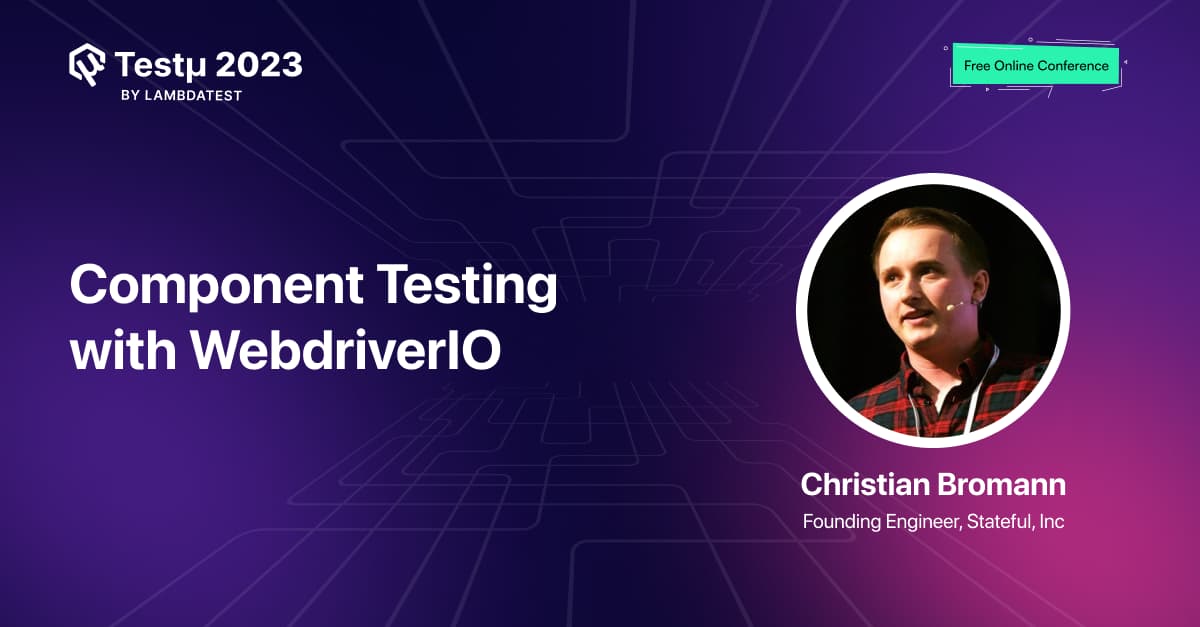Explore the significance of web component testing in modern testing stacks and learn to scrutinize UI components to reduce e2e overhead.
In the session, Christian Bromann will explore WebdriverIO v8’s browser runner capabilities, enabling direct browser execution for seamless component testing.
Still not registered? Hurry up and grab your free tickets: Register Now!
If you have already registered and up for the session, feel free to post your questions in the thread below 
Let’s look at some of the Q&As from the session!
Could you discuss the role of mocks and stubs in component testing with WebdriverIO and their impact on test speed and reliability?
Christian: Absolutely. For me, component mocks and stubs are the most important part when it comes to testing. I want to decide whether I want to test a component that includes other components or if I just want to exclude them completely. Mocks and stubs are essential for writing stable and fast tests. Sometimes, a component depends on another component that requires computation or loads unnecessary things. You can mock and stub these out using WebdriverIO, even in the browser, for all frameworks.
What should be the scope of component tests? What kind of validation should be done?
Christian: Every feature your component supports can be a part of its component test. For instance, even a navigation component that includes many sub-components can be tested as a whole. It’s up to you how you want to define the scope.
Depending on the component being tested, you can decide how many other components you want to include. If you can encapsulate and test them separately, and if you can mock out dependencies, then expanding the scope of your component test can provide more confidence. It allows you to test a broader stack of your application’s front end. The flexibility of component testing lets you define the scope based on your specific situation.
Here are some of the unanswered questions:
Why use WebdriverIO instead of Selenium, given that Selenium has been there for a long time?
How does WebdriverIO handle asynchronous operations and assertions in the context of component testing?
Does WebdriverIO support Electron apps as well?
What’s an advantage of using WebdriverIO for component testing as compared to Playwright?
Can WebdriverIO be used for API testing?
Could you elaborate on why browser-based testing is preferable and how it enhances the accuracy of testing?
Could you provide insights into how WebdriverIO v8 enables seamless interaction with components during testing?
Could you explain how WebdriverIO’s browser runner approach caters to testing components across these different frameworks?
Hi there,
If you couldn’t catch the session live, don’t worry! You can watch the recording here:
Additionally, we’ve got you covered with a detailed session blog:
This is a very good question. Yes, WebdriverIO can be used for API testing, but in my opinion, it’s not its primary purpose. WebdriverIO is primarily designed for end-to-end testing of web applications using the WebDriver protocol. It allows you to control browsers and simulate user interactions on web pages. While it excels in web testing, you can also utilize it for API testing by making HTTP requests and assertions against the API responses.
However, for API testing, there are more specialized tools and libraries like Postman, and Insomnia, or libraries in programming languages like Python’s requests or JavaScript’s Axios that are better suited and offer more features specifically tailored for API testing. So, while WebdriverIO can perform API testing, it’s advisable to consider dedicated API testing tools for more efficient and comprehensive testing of APIs.
In my opinion, Browser-based testing is preferred for several compelling reasons that enhance testing accuracy. First and foremost, it closely mimics real-world user interactions. When we test software in a web browser, we replicate how actual users will access and use the application. This helps us uncover issues that might not be apparent in other testing environments, such as differences in browser rendering or user experience.
Additionally, browser-based testing allows for better cross-browser compatibility checks. As websites and web applications need to function smoothly across various browsers like Chrome, Firefox, Safari, and Edge, testing in the specific browsers helps identify and rectify browser-specific bugs. This approach minimizes the chances of users encountering compatibility issues, making the software more reliable and user-friendly.
Absolutely, I’d be happy to provide insights into how WebdriverIO v8 enables seamless interaction with components during testing.
WebdriverIO v8 introduces several powerful features that make component interaction a breeze. One key feature is the integration of the "$: " selector. This allows you to easily select and interact with web components by their names, making your tests more readable and maintainable.
Additionally, WebdriverIO v8 offers improved handling of shadow DOM elements, making it simpler to interact with components encapsulated within shadow DOM. The new shadow$ and shadow$ methods streamline this process.
Furthermore, WebdriverIO v8’s enhanced support for mobile testing simplifies component interaction on mobile devices. With improved mobile emulation and device interaction capabilities, you can seamlessly test components across various platforms.
That is really good question. WebdriverIO’s browser runner approach is designed to seamlessly cater to testing components across various frameworks. It achieves this by offering a powerful and flexible automation framework that abstracts away the complexities of different frameworks, ensuring a consistent and efficient testing experience.
WebdriverIO’s browser runner allows you to write tests using a single, unified syntax regardless of the underlying framework your web application uses. It supports multiple testing frameworks like Mocha, Jasmine, and Cucumber, making it adaptable to your project’s specific needs.
This approach also provides excellent browser compatibility, making it easy to test components across different web browsers and versions. WebdriverIO leverages the WebDriver protocol to interact with web browsers, ensuring cross-browser compatibility without the need for extensive code modifications. I hope that answer your question.
Certainly! WebDriverIO is a fantastic choice over Selenium for a few reasons. Even though Selenium has been around for a while, WebdriverIO offers some key advantages.
First, WebDriverIO is built on top of Selenium, which means it inherits all of Selenium’s capabilities while adding its own improvements. This means you get the best of both worlds.
Second, it is more developer-friendly. It has a simpler and more intuitive API that makes writing test scripts easier and faster. This can save you a lot of time and effort.
And lastly, WebdriverIO has a vibrant and active community that continuously updates and supports it. This ensures that you have access to the latest features and fixes, making your testing more reliable and up-to-date.
Sure, I’d be happy to explain how WebdriverIO handles asynchronous operations and assertions in component testing.
WebdriverIO is a powerful tool for testing web applications. When it comes to handling asynchronous operations, WebdriverIO uses a concept called “Promises.” Promises allow the test to wait for an element or action to complete before moving on to the next step. This helps ensure that your tests run smoothly, even when dealing with elements that load or change asynchronously on a web page.
As for assertions, WebdriverIO provides built-in assertion methods that make it easy to check if elements on a page meet the expected criteria. These assertions help you verify that your web components are behaving correctly. You can customize your assertions to check for things like the presence of an element, its text, or its attributes.
Absolutely! WebdriverIO is fantastic for testing Electron apps. It offers an integrated service that streamlines interactions with your Electron application, making the testing process straightforward and efficient. So, you can confidently use WebdriverIO to test your Electron apps without any hassle.
Certainly! WebdriverIO and Playwright are both powerful tools for component testing, but WebdriverIO offers some distinct advantages.
Firstly, WebdriverIO has a larger community and a longer track record. This means you can find more resources, support, and plugins, making it easier to get started and solve issues.
Secondly, WebdriverIO supports a wider range of browsers, which is important for cross-browser testing. It works with popular browsers like Chrome, Firefox, and Safari, ensuring your components work consistently across different environments.
Additionally, WebdriverIO’s API is more user-friendly and follows the WebDriver standard, which means it’s easier to understand and work with for those familiar with Selenium.
However, it does not make the Playwright less reliable. It came into the market recently and booming like a rocket. You can make the choice as per your test cases.
![]()

